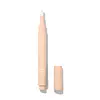e.l.f. cosmetics Flawless Brightening Concealer Versus IT Cosmetics Bye Bye Undereye Illumination Full Coverage Anti-Aging Waterproof Concealer
What's inside
What's inside
 Key Ingredients
Key Ingredients

 Benefits
Benefits

 Concerns
Concerns

 Ingredients Side-by-side
Ingredients Side-by-side

Water
Skin ConditioningDimethicone
EmollientButylene Glycol
HumectantTriethylhexanoin
MaskingOctyldodecanol
EmollientMica
Cosmetic ColorantLauryl PEG-9 Polydimethylsiloxyethyl Dimethicone
Skin ConditioningSilica
AbrasiveMagnesium Sulfate
Diglycerin
HumectantDisteardimonium Hectorite
StabilisingPhenoxyethanol
PreservativeLauryl PEG-10 Tris(Trimethylsiloxy)Silylethyl Dimethicone
EmulsifyingPropylene Carbonate
SolventAluminum PCA
AstringentTriethoxycaprylylsilane
Hexylglycerin
HumectantCaprylyl Glycol
EmollientDisodium EDTA
Dipropylene Glycol
HumectantSodium Citrate
BufferingTocopherol
AntioxidantSodium Hyaluronate
HumectantSodium Alum
AstringentCI 77891
Cosmetic ColorantIron Oxides
Water, Dimethicone, Butylene Glycol, Triethylhexanoin, Octyldodecanol, Mica, Lauryl PEG-9 Polydimethylsiloxyethyl Dimethicone, Silica, Magnesium Sulfate, Diglycerin, Disteardimonium Hectorite, Phenoxyethanol, Lauryl PEG-10 Tris(Trimethylsiloxy)Silylethyl Dimethicone, Propylene Carbonate, Aluminum PCA, Triethoxycaprylylsilane, Hexylglycerin, Caprylyl Glycol, Disodium EDTA, Dipropylene Glycol, Sodium Citrate, Tocopherol, Sodium Hyaluronate, Sodium Alum, CI 77891, Iron Oxides
Caprylic/Capric Triglyceride
MaskingBis-Diglyceryl Polyacyladipate-2
EmollientVp/Hexadecene Copolymer
Cetyl Alcohol
EmollientSilica Dimethyl Silylate
EmollientMicrocrystalline Wax
Emulsion StabilisingPhenoxyethanol
PreservativeNiacinamide
SmoothingSodium Hyaluronate
HumectantMagnesium Ascorbyl Phosphate
AntioxidantTocopheryl Acetate
AntioxidantAscorbyl Palmitate
AntioxidantHydrolyzed Collagen
EmollientWater
Skin ConditioningPentaerythrityl Tetra-Di-T-Butyl Hydroxyhydrocinnamate
AntioxidantCholesteryl Isostearate
EmollientCholesteryl Chloride
Skin ConditioningCholesteryl Nonanoate
EmollientGlycerin
HumectantSteareth-20
CleansingSilica
AbrasiveChlorhexidine Digluconate
AntimicrobialN-Hydroxysuccinimide
Skin ConditioningBHT
AntioxidantSodium Citrate
BufferingPotassium Sorbate
PreservativePalmitoyl Tripeptide-1
Skin ConditioningChrysin
Skin ConditioningPalmitoyl Tetrapeptide-7
Skin ConditioningCitric Acid
BufferingBiotin
AntiseborrhoeicTitanium Dioxide
Cosmetic ColorantIron Oxides
Mica
Cosmetic ColorantCaprylic/Capric Triglyceride, Bis-Diglyceryl Polyacyladipate-2, Vp/Hexadecene Copolymer, Cetyl Alcohol, Silica Dimethyl Silylate, Microcrystalline Wax, Phenoxyethanol, Niacinamide, Sodium Hyaluronate, Magnesium Ascorbyl Phosphate, Tocopheryl Acetate, Ascorbyl Palmitate, Hydrolyzed Collagen, Water, Pentaerythrityl Tetra-Di-T-Butyl Hydroxyhydrocinnamate, Cholesteryl Isostearate, Cholesteryl Chloride, Cholesteryl Nonanoate, Glycerin, Steareth-20, Silica, Chlorhexidine Digluconate, N-Hydroxysuccinimide, BHT, Sodium Citrate, Potassium Sorbate, Palmitoyl Tripeptide-1, Chrysin, Palmitoyl Tetrapeptide-7, Citric Acid, Biotin, Titanium Dioxide, Iron Oxides, Mica
Ingredients Explained
These ingredients are found in both products.
Ingredients higher up in an ingredient list are typically present in a larger amount.
Mica is a naturally occurring mineral used to add shimmer and color in cosmetics. It can also help improve the texture of a product or give it an opaque, white/silver color.
Serecite is the name for very fine but ragged grains of mica.
This ingredient is often coated with metal oxides like titanium dioxide. Trace amounts of heavy metals may be found in mica, but these metals are not harmful in our personal products.
Mica has been used since prehistoric times throughout the world. Ancient Egyptian, Indian, Greek, Roman, Aztec, and Chinese civilizations have used mica.
Learn more about MicaPhenoxyethanol is a preservative that has germicide, antimicrobial, and aromatic properties. Studies show that phenoxyethanol can prevent microbial growth. By itself, it has a scent that is similar to that of a rose.
It's often used in formulations along with Caprylyl Glycol to preserve the shelf life of products.
Silica, also known as silicon dioxide, is a naturally occurring mineral. It is used as a fine, spherical, and porous powder in cosmetics.
Though it has exfoliant properties, the function of silica varies depending on the product.
The unique structure of silica enhances the spreadability and adds smoothness, making it a great texture enhancer.
It is also used as an active carrier, emulsifier, and mattifier due to its ability to absorb excess oil.
In some products, tiny microneedles called spicules are made from silica or hydrolyzed sponge. When you rub them in, they lightly polish away dead skin layers and enhance the penetration of active ingredients.
Learn more about SilicaSodium Citrate is the sodium salts of citric acid. In skincare, it is used to alter pH levels and acts as a preservative.
Its main functions are to maintain the pH of a product and neutralize metal ions.
The acidity of our skin is maintained by our glands and skin biome; normal pH level of skin is slightly acidic (~4.75-5.5).
Being slightly acidic allows our skin to create an "acid mantle". This acid mantle is a thin barrier that protects our skin from bacteria and contaminants.
Learn more about Sodium CitrateSodium Hyaluronate is hyaluronic acid's salt form. It is commonly derived from the sodium salt of hyaluronic acid.
Like hyaluronic acid, it is great at holding water and acts as a humectant. This makes it a great skin hydrating ingredient.
Sodium Hyaluronate is naturally occurring in our bodies and is mostly found in eye fluid and joints.
These are some other common types of Hyaluronic Acid:
Learn more about Sodium HyaluronateWater. It's the most common cosmetic ingredient of all. You'll usually see it at the top of ingredient lists, meaning that it makes up the largest part of the product.
So why is it so popular? Water most often acts as a solvent - this means that it helps dissolve other ingredients into the formulation.
You'll also recognize water as that liquid we all need to stay alive. If you see this, drink a glass of water. Stay hydrated!
Learn more about WaterThis ingredient is a combination of red, black, and yellow iron oxide pigments. This combination of colors is usually found in foundation, because it results in a "skin" color.